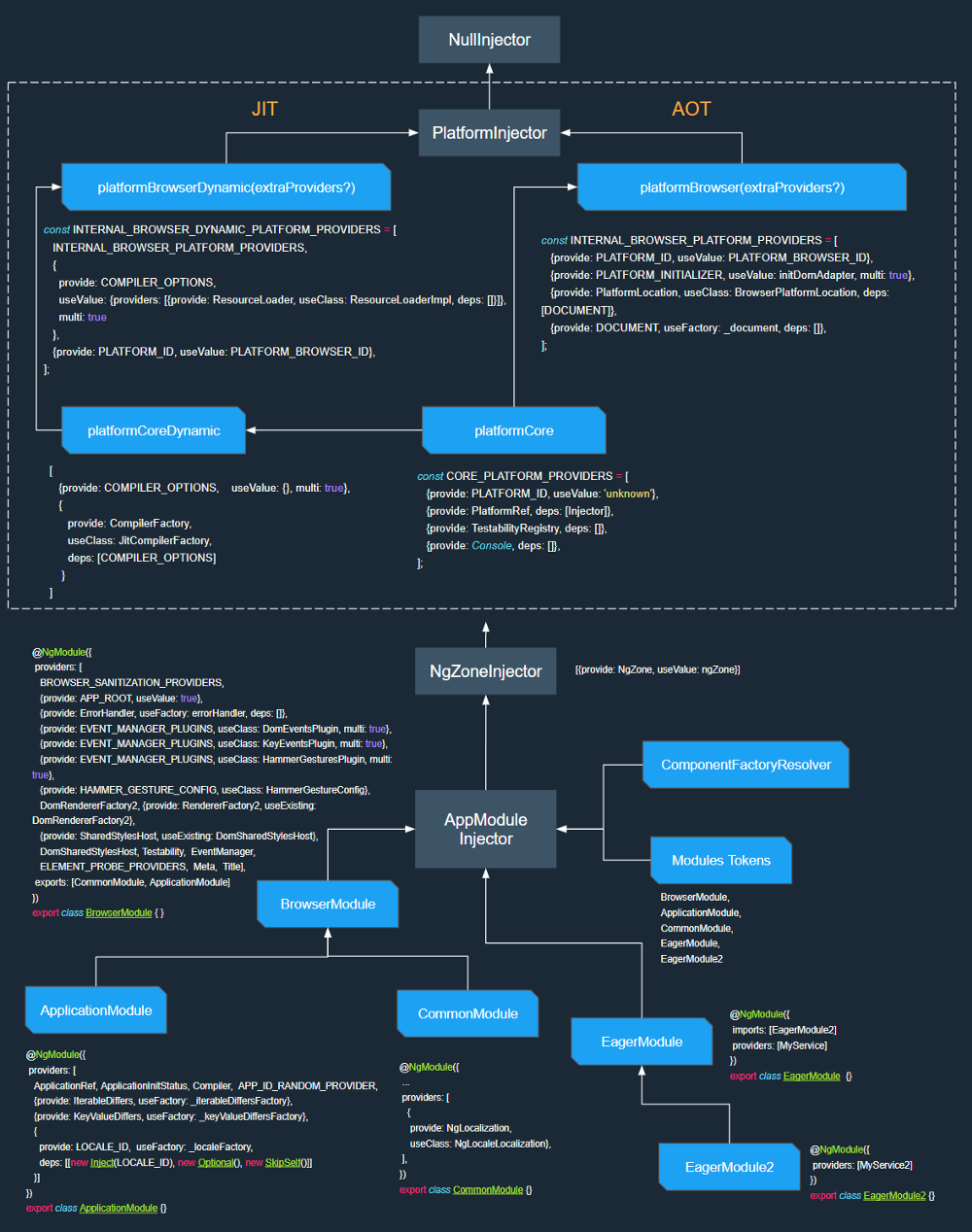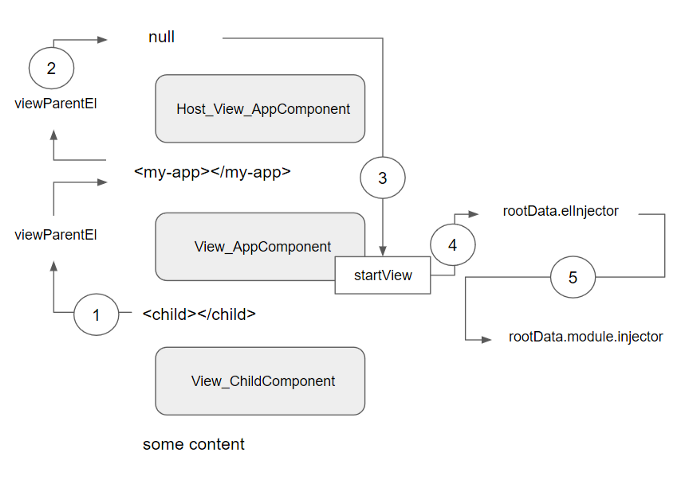Angular框架解读--多级依赖注入设计
更新日期:
作为“为大型前端项目”而设计的前端框架,Angular 其实有许多值得参考和学习的设计,本系列主要用于研究这些设计和功能的实现原理。本文主要围绕 Angular 中的最大特点——依赖注入,介绍 Angular 中多级依赖注入的设计。
上一篇我们介绍了 Angular 中的Injectot注入器、Provider提供者,以及注入器机制。那么,在 Angular 应用中,各个组件和模块间又是怎样共享依赖的,同样的服务是否可以多次实例化呢?
组件和模块的依赖注入过程,离不开 Angular 多级依赖注入的设计,我们来看看。
多级依赖注入
前面我们说过,Angular 中的注入器是可继承、且分层的。
在 Angular 中,有两个注入器层次结构:
ModuleInjector模块注入器:使用@NgModule()或@Injectable()注解在此层次结构中配置ModuleInjectorElementInjector元素注入器:在每个 DOM 元素上隐式创建
模块注入器和元素注入器都是树状结构的,但它们的分层结构并不完全一致。
模块注入器
模块注入器的分层结构,除了与应用中模块设计有关系,还有平台模块(PlatformModule)注入器与应用程序模块(AppModule)注入器的分层结构。
平台模块(PlatformModule)注入器
在 Angular 术语中,平台是供 Angular 应用程序在其中运行的上下文。Angular 应用程序最常见的平台是 Web 浏览器,但它也可以是移动设备的操作系统或 Web 服务器。
Angular 应用在启动时,会创建一个平台层:
- 平台是 Angular 在网页上的入口点,每个页面只有一个平台
- 页面上运行的每个 Angular 应用程序,所共有的服务都在平台内绑定
一个 Angular 平台,主要包括创建模块实例、销毁等功能:
1 | () |
实际上,平台在启动的时候(bootstrapModuleFactory方法中),在ngZone.run中创建ngZoneInjector,以便在 Angular 区域中创建所有实例化的服务,而ApplicationRef(页面上运行的 Angular 应用程序)将在 Angular 区域之外创建。
在浏览器中启动时,会创建浏览器平台:
1 | export const platformBrowser: (extraProviders?: StaticProvider[]) => PlatformRef = |
使用平台工厂(例如上面的createPlatformFactory)创建平台时,将隐式初始化页面的平台:
1 | export function createPlatformFactory( |
通过以上过程,我们知道 Angular 应用在创建平台的时候,创建平台的模块注入器ModuleInjector。我们从上一节Injector定义中也能看到,NullInjector是所有注入器的顶部:
1 | export abstract class Injector { |
因此,在平台模块注入器之上,还有NullInjector()。而在平台模块注入器之下,则还有应用程序模块注入器。
应用程序根模块(AppModule)注入器
每个应用程序有至少一个 Angular 模块,根模块就是用来启动此应用的模块:
1 | ({ providers: APPLICATION_MODULE_PROVIDERS }) |
AppModule根应用模块由BrowserModule重新导出,当我们使用 CLI 的new命令创建新应用时,它会自动包含在根AppModule中。应用程序根模块中,提供者关联着内置的 DI 令牌,用于为引导程序配置根注入器。
Angular 还将ComponentFactoryResolver添加到根模块注入器中。此解析器存储了entryComponents系列工厂,因此它负责动态创建组件。
模块注入器层级
到这里,我们可以简单地梳理出模块注入器的层级关系:
- 模块注入器树的最上层则是应用程序根模块(AppModule)注入器,称作 root。
- 在 root 之上还有两个注入器,一个是平台模块(PlatformModule)注入器,一个是
NullInjector()。
因此,模块注入器的分层结构如下:
在我们实际的应用中,它很可能是这样的:

Angular DI 具有分层注入体系,这意味着下级注入器也可以创建它们自己的服务实例。
元素注入器
前面说过,在 Angular 中有两个注入器层次结构,分别是模块注入器和元素注入器。
元素注入器的引入
当 Angular 中懒加载的模块开始广泛使用时,出现了一个 issue:依赖注入系统导致懒加载模块的实例化加倍。
在这一次修复中,引入了新的设计:注入器使用两棵并行的树,一棵用于元素,另一棵用于模块。
Angular 会为所有entryComponents创建宿主工厂,它们是所有其他组件的根视图。
这意味着每次我们创建动态 Angular 组件时,都会使用根数据(RootData)创建根视图(RootView):
1 | class ComponentFactory_ extends ComponentFactory<any>{ |
该根数据(RootData)包含对elInjector和ngModule注入器的引用:
1 | function createRootData( |
引入元素注入器树,原因是这样的设计比较简单。通过更改注入器层次结构,避免交错插入模块和组件注入器,从而导致延迟加载模块的双倍实例化。因为每个注入器都只有一个父对象,并且每次解析都必须精确地寻找一个注入器来检索依赖项。
元素注入器(Element Injector)
在 Angular 中,视图是模板的表示形式,它包含不同类型的节点,其中便有元素节点,元素注入器位于此节点上:
1 | export interface ElementDef { |
默认情况下ElementInjector为空,除非在@Directive()或@Component()的providers属性中进行配置。
当 Angular 为嵌套的 HTML 元素创建元素注入器时,要么从父元素注入器继承它,要么直接将父元素注入器分配给子节点定义。
如果子 HTML 元素上的元素注入器具有提供者,则应该继承该注入器。否则,无需为子组件创建单独的注入器,并且如果需要,可以直接从父级的注入器中解决依赖项。
元素注入器与模块注入器的设计
那么,元素注入器与模块注入器是从哪个地方开始成为平行树的呢?
我们已经知道,应用程序根模块(AppModule)会在使用 CLI 的new命令创建新应用时,自动包含在根AppModule中。
当应用程序(ApplicationRef)启动(bootstrap)时,会创建entryComponent:
1 | const compRef = componentFactory.create(Injector.NULL, [], selectorOrNode, ngModule); |
该过程会使用根数据(RootData)创建根视图(RootView),同时会创建根元素注入器,在这里elInjector为Injector.NULL。
在这里,Angular 的注入器树被分成元素注入器树和模块注入器树,这两个平行的树了。
Angular 会有规律的创建下级注入器,每当 Angular 创建一个在@Component()中指定了providers的组件实例时,它也会为该实例创建一个新的子注入器。类似的,当在运行期间加载一个新的NgModule时,Angular 也可以为它创建一个拥有自己的提供者的注入器。
子模块和组件注入器彼此独立,并且会为所提供的服务分别创建自己的实例。当 Angular 销毁NgModule或组件实例时,也会销毁这些注入器以及注入器中的那些服务实例。
Angular 解析依赖过程
上面我们介绍了 Angular 中的两种注入器树:模块注入器树和元素注入器树。那么,Angular 在提供依赖时,又会以怎样的方式去进行解析呢。
在 Angular 种,当为组件/指令解析 token 获取依赖时,Angular 分为两个阶段来解析它:
- 针对
ElementInjector层次结构(其父级) - 针对
ModuleInjector层次结构(其父级)
其过程如下(参考多级注入器-解析规则):
- 当组件声明依赖项时,Angular 会尝试使用它自己的
ElementInjector来满足该依赖。 - 如果组件的注入器缺少提供者,它将把请求传给其父组件的
ElementInjector。 - 这些请求将继续转发,直到 Angular 找到可以处理该请求的注入器或用完祖先
ElementInjector。 - 如果 Angular 在任何
ElementInjector中都找不到提供者,它将返回到发起请求的元素,并在ModuleInjector层次结构中进行查找。 - 如果 Angular 仍然找不到提供者,它将引发错误。
为此,Angular 引入一种特殊的合并注入器。
合并注入器(Merge Injector)
合并注入器本身没有任何值,它只是视图和元素定义的组合。
1 | class Injector_ implements Injector { |
当 Angular 解析依赖项时,合并注入器则是元素注入器树和模块注入器树之间的桥梁。当 Angular 尝试解析组件或指令中的某些依赖关系时,会使用合并注入器来遍历元素注入器树,然后,如果找不到依赖关系,则切换到模块注入器树以解决依赖关系。
1 | class ViewContainerRef_ implements ViewContainerData { |
解析过程
注入器是可继承的,这意味着如果指定的注入器无法解析某个依赖,它就会请求父注入器来解析它。具体的解析算法在resolveDep()方法中实现:
1 | export function resolveDep( |
如果是<child></child>这样模板的根AppComponent组件,那么在 Angular 中将具有三个视图:
1 | <!-- HostView_AppComponent --> |
依赖解析过程,解析算法会基于视图层次结构,如图所示进行:

如果在子组件中解析某些令牌,Angular 将:
- 首先查看子元素注入器,进行检查
elRef.element.allProviders|publicProviders。 - 然后遍历所有父视图元素(1),并检查元素注入器中的提供者。
- 如果下一个父视图元素等于
null(2),则返回到startView(3),检查startView.rootData.elnjector(4)。 - 只有在找不到令牌的情况下,才检查
startView.rootData module.injector( 5 )。
由此可见,Angular 在遍历组件以解析某些依赖性时,将搜索特定视图的父元素而不是特定元素的父元素。视图的父元素可以通过以下方法获得:
1 | // 对于组件视图,这是宿主元素 |
总结
本文主要介绍了 Angular 中注入器的层级结构,在 Angular 中有两棵平行的注入器树:模块注入器树和元素注入器树。
元素注入器树的引入,主要是为了解决依赖注入解析懒加载模块时,导致模块的双倍实例化问题。在元素注入器树引入后,Angular 解析依赖的过程也有调整,优先寻找元素注入器以及父视图元素注入器等注入器的依赖,只有元素注入器中无法找到令牌时,才会查询模块注入器中的依赖。
参考

码生艰难,写文不易,给我家猪囤点猫粮了喵~
查看Github有更多内容噢:https://github.com/godbasin
更欢迎来被删的前端游乐场边撸猫边学前端噢
如果你想要关注日常生活中的我,欢迎关注“牧羊的猪”公众号噢
